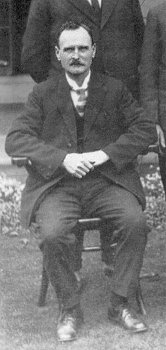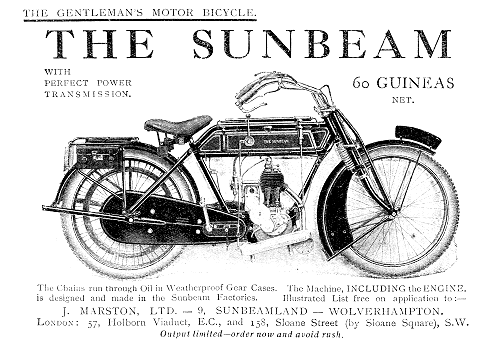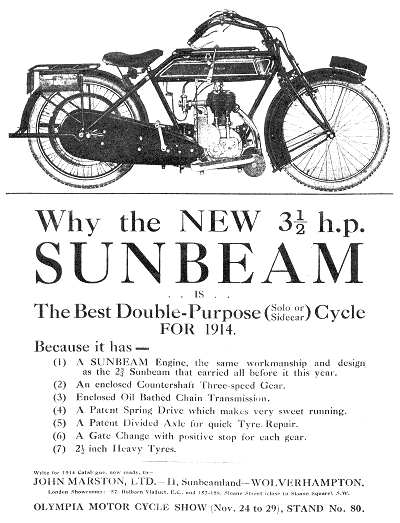| The Early Years
During 1903 and 1904 John Marston and his sons
were experimenting with motorcycles. It is thought that they were
using a Swiss "Motosacoche" engine mounted on a modified Sunbeam
bicycle. Some of the Sunbeam employees were clearly giving thought
to motorcycle production because in 1903 James Morgan, the Deputy
Works Manager patented a "Little Oil Bath" for chain driven
motorcycles. This work came to an end in 1904 when one of the
company's employees was killed on one of the experimental
prototypes. After the accident John Marston decreed that no more
work would be carried out on these machines in his factory. It seems
that he never liked them in the first place.
John's aversion for
motorcycles continued for several years, during which time much of
the early development had taken place and many successful machines
had been manufactured locally. His thoughts eventually turned back
in
this direction in 1911/1912 and he engaged John Greenwood, who had
previously worked for Rover and JAP to develop a Sunbeam motorcycle. |
|

Harry Stevens. |
The best local motorcycle
designer was Harry Stevens, one of the four Stevens brothers who ran
A. J. Stevens & Company Limited, just up the road in Retreat Street.
Harry would later become well known for his A.J.S. motorcycles that
were produced in vast numbers at Graiseley Hill.
Harry was employed
by Sunbeam as a consulting engineer and he designed the first
Sunbeam motorcycle, a 349 c.c, 2¾ hp. single-cylinder, side-valve
machine, with two speed transmission and a forward mounted magneto.
John Greenwood then had the task of preparing it for production. He
only made two major modifications which were to place the magneto
behind the cylinder and to use a Renold chain running in a little
oil bath chain case, to a Sharp divided rear axle.
There was a single plate
clutch in the chain case and a well designed two-speed gearbox,
which was mounted on a machined frame lug for adjustment. The
exhaust pipe led to a 'pepperpot' type silencer and the machine
had a diamond pattern frame and Druid type forks. The machine was
finished in the usual Sunbeam black, but the early petrol tanks were
finished in green with a silver panel bearing the Sunbeam name. |
|
Into Production
The first machines went into
production in 1912 and were soon a great success, eventually overshadowing
the company's bicycles. They became known as "The Gentleman's
Motorcycle". Initially sales were only conducted at existing bicycle
sales depots. The machines were hand built, with a selling price of 60 guineas. Almost immediately they featured in
competitions and were very successful. Two Sunbeam machines gained
gold medals in the London-Exeter-London trial, in December 1912, and
the Sunbeam name became well-known to enthusiasts throughout the
country. |

An advert from 1912.
|
Minor changes were made to
the 1913 version, and the familiar black and gold-lined finish made
its appearance. June saw the launch of a 6 hp. machine, powered by a
JAP 76 mm. x 85 mm. twin engine. It had a 3-speed gearbox, and was a
similar design to the 2¾ hp. machine,
but with a larger and
stronger frame, Druid type forks, and Senspray carburettor. In
September, a 3½ hp. machine was
launched. It had the same layout as the 2¾ hp. model and included a 3-speed gearbox,
and a 1½ gallon
fuel tank, which could hold 1½ gallons of petrol and 2 pints of oil.
The engine had an 85 mm. bore, 88 mm. stroke, and developed 3½ hp. at
4,000 r.p.m. A Sharp divided axle was fitted to the rear wheel, which
allowed the easy removal of the inner tube, and the rear mudguard
hinged upwards for easy removal of the rear wheel. The machine sold
for 66 guineas.
Sunbeam machines were
entered in many of the sporting events and competitions that were
well reported in the press. Sunbeam employees, John Greenwood, Tommy
de la Hay, and Howard Davies became familiar figures at these events
and won many medals. Sunbeam machines were also entered by private
individuals, and the company became well-known for its racing
successes. During the summer, Sunbeam machines were ridden up three
mountains in what was basically a publicity exercise. Snowdon was
climbed on June 6th, Ben Nevis on July 13th, and Mount Tosari
(5,825ft) in Java, was climbed a little later in the year. 1913 was
a successful year and sales were good. |

An advert from 1913.
|
The first two Sunbeam
sidecars made their appearance in 1914. They were both made by
'Gloria' and were called the 'Gloria Number 1' and the 'Gloria
Number 2'. Number 1 was for the 3½ hp. machine and sold for 15
guineas, and number 2 for the 6 hp. machine, sold for 24 guineas.
Development continued and minor improvements were made to the 3½ hp.
and 6 hp. machines.
Sunbeam's success in
sporting events continued. Tommy de la Hay and John Greenwood won
gold medals in the 'Midland Reliability Trial', riding 6 hp.
machines. Vernon Dudley, Charlie Nokes and Joe Dudley won awards on
3½ hp. machines. The most notable racing success of the year was
achieved by Howard Davies, who came joint-second in the senior T.T.
Sunbeam also won the team prize. |

|
|

|
|

|
| Return to the
beginning |
|
Return to the list
of manufacturers |
|
Proceed to The War
Years |
|